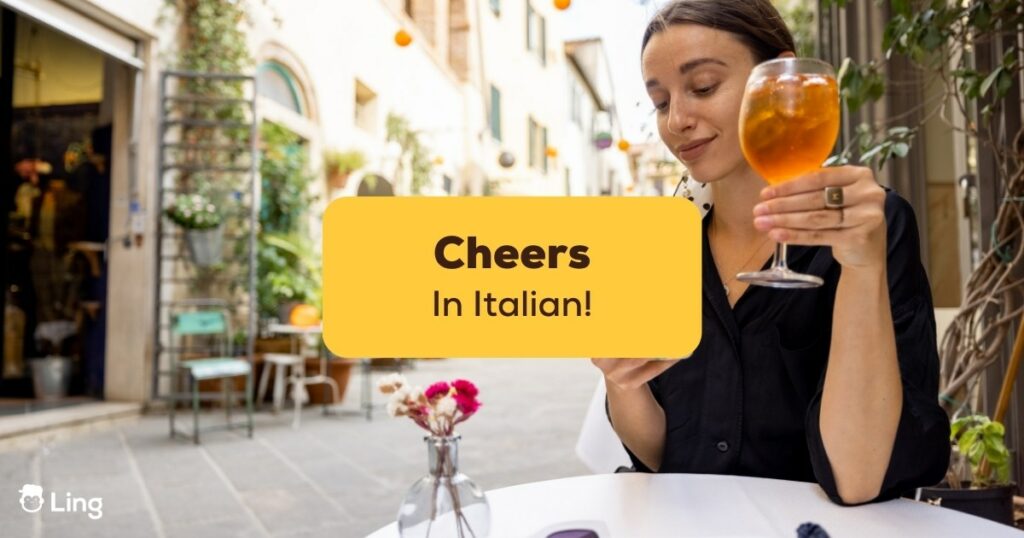Would you like to know how to say cheers in Italian? In Italy, there are specific rules of etiquette to follow to maintain good manners and positively impress other people. Remember, if you are invited to the house of Italian friends, it is essential to have a little knowledge of their rituals during a toast and how to say cheers in Italian.
Here is everything there is to know about making a toast in Italian.
How To Say Cheers In Italian?
Italians can cheer in different ways and use various phrases and words depending on the situation. The most popular way to cheer is using the word:
“Salute” – Cheers (literally means “health”)
But Italians can also use other words. For example, here are some common phrases:
- Alla tua salute – To your health
- Alla nostra salute – To our health
- Alla vostra – To yours
- Beviamo alla nostra – Let’s drink to ours
- Cento di questi giorni – One hundred of these days
- Vi auguro il meglio – I wish you the best
- Alla Salute- To Health (literal translation)
- Viva [name or thing to cheer] – Long live [person or object] or hurray for [person or thing]
- Cin-Cin – Cheers
If you cheer using the word “salute,” you will do just fine on almost all occasions. It is perfectly acceptable only to say this word.
But if you want to sound original and change the meaning slightly, you can also use the other variations. For example, you might like to wish good health and many good things to others during a toast.
The term salute is also used in the Italian language to signify other things, such as:
- To wish the person good health.
- As a greeting.
- To express wonder, disbelief, and surprise.
“Fare un brindisi” is the Italian expression for “making a toast.”

Are Italian Still Using Cin-Cin?
In the Italian tradition, it was common to say “Cin-Cin” during a toast, but now it is mainly replaced by the word “Salute.” It is because fashion has changed, and now Italians use unique ways to cheer. However, you could still meet some people using this expression.
It is a common belief that “chin-chin” comes from Chinese sailors. They brought this expression to Italy, where the general population used it for some time before disappearing from the customs and traditions of the Italians.
Cin-Cin comes from the Chinese words “Ch’ing Ch’ing,” which means “Please Please,” which was a way to show gratitude.
Etiquette During The Toast
It makes sense to learn the proper etiquette when going to a party or when invited to a family event. For example, you will feel more confident knowing what is right and wrong if you sit at a dinner table and the host asks everyone to make a toast.
Here is what you should keep in mind:
- Touching glasses is not supposed to be done.
- Do not cross arms or glassed with others.
- The first toast is made by the host.
- The person proposing a toast raises the glass toward the receiver of the toast and spends a few nice words before inviting everyone to cheer.
- The participants do not require clinking glasses.
- The guests should only raise their glasses and look at the eyes of the receiver with a friendly smile.
- The receiver of the toast should raise the glass at the end of the toast and thank others.
A toast is a good way of wishing good health to others during events or Italian celebrations, even during a formal setting such as business events or office parties.
Although you might see people clink glasses in movies, it is not part of Italian etiquette to have any glass touching. It is only necessary to point the glass toward the person celebrated before sipping from it.
The Italian etiquette wants the host to make the first toast. Others can do the same later on during the event for a different purpose or give their best wishes to someone else.

An important fact to remember is that Italian tradition says that each drink should have its type of glass. For example, wine would have a different glass than sparkling wine, beer, or champagne. You need to use delicate glasses for sparkling wines while, and champagne has a distinct type of glass.
The Origin Of The Toasts
Toasting rituals go back to many years ago, through the medieval period, when there was the habit of toasting by touching glasses with other people. During that period, people would touch glasses energetically.
Some drops of wine would get from one glass to another, so the host and the guests were sure that no poison was in the drink.
Would you like to know more interesting things about the Italian language? You can also read 15 Funny Italian Phrases And Their Meanings!
Ready To Learn More Italian?

Congratulations! You’ve become skilled in how to say cheers in Italian. To add even more expressions to your vocabulary, you can read out our posts on Italian insults and happy birthday in Italian.
Are you curious about learning Italian or other languages? If so, try the Ling app!
Ling app is an interactive language learning software that contains all the necessary tools to learn any language you want. With this tool, you have the freedom to learn Italian when you most feel comfortable. In addition, you can take advantage of the mobile app or study from your home computer.
If you want to study more languages, you can choose between 60 or more languages with the Ling App. So what are you waiting for?
Download the language learning app from Google Play or App Store for free today!













